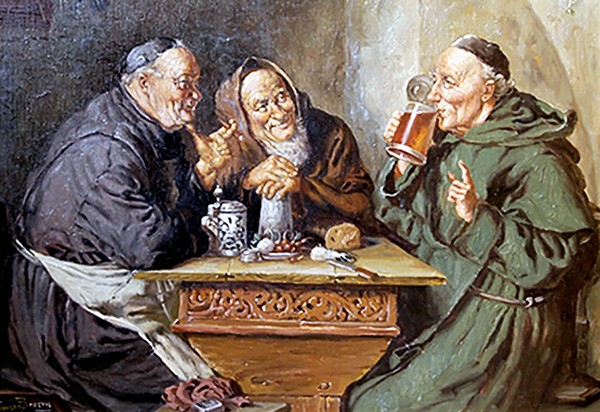No, seriously. While the annual Christian period of penitence and fasting began this week, an all-beer Lenten diet originally established by a 17th-century order of monks is gaining traction with contemporary churchgoers.
As the story goes — or according to a fantastic account on the booze blog Lords of the Drinks — in 1634, a group of Catholic monks from the Order of Francis of Paola created a hearty doppelbock beer, or “liquid bread,” that was packed with enough carbs and calories to sustain them for the 46 days between Fat Tuesday and Easter “without a bite of solid food.”
The doppelbock was believed to cleanse the body and purify the soul, and for the next 65 years, it was so employed. Then, around 1700, the monks feared that the beer might be too tasty and enjoyable during Lent, so they sent a sample to the Pope to get an official opinion. As the barrel made its way across the Alps from Munich to Rome, the beer spoiled. The Pope thought it was utterly vile — and therefore suitable for Lenten penitence — and thus he decreed that the monks should drink it as frequently as possible. And so a tradition was born!

Today, that doppelbock is brewed under the brand Paulaner Salvator. And the Doppelbock Diet is a legitimate trend. Six years ago, Catholic homebrewer J. Wilson substituted four doppelbocks a day (five on weekends) for meals for 46 days. The Iowan lost more than 25 pounds in the process, reporting to CNN that he “never felt so rejuvenated, physically or mentally.” Wilson brewed his own batch of doppelbock for the experiment, which he also chronicled in the memoir Diary of a Part-Time Monk. Should you decide to attempt your own version of the fast, there’s no need to brew your own: You ought to be able to stock your fridge at any good beer purveyor.
The Catholic Gentleman, aka Oklahoma blogger Sam Guzman, recommends five well-known German doppelbocks, including the original Paulaner Salvator. Also on his list: Weltenburger Kloster Asam Bock, La Trappe Bockbier, Andechser Doppelbock Dunkel, which is brewed by the Benedictine Monks of Saint Boniface, and Weihenstephaner Korbinian, which is brewed at one of the oldest breweries in the world, founded in 725 by Saint Corbinian.
Here in Memphis, there don’t seem to be many doppelbocks on tap. The exception: Flying Saucer, with Samichlaus Bier Helles (14 percent ABV) currently available. Described as “a noticeably strong, rich, and very malty German-style lager,” it’s definitely a beer that’s for sipping, not gulping. You may be able to find Abita Andygator (8 percent ABV) available by the keg, if you call around; brewed in Louisiana, the Andygator is a formidable New World approximation of a traditional doppelbock.
If you can’t find enough doppelbock to tide you over, look for any beer with approximately 300 calories per twelve ounces. You’ll need a nutritious brew that tastes yeasty with plenty of B-complex vitamins.
Try seeking out bottle-conditioned beers, which, according to Men’s Health, were once medically prescribed to patients with vitamin deficiencies. Bottle-conditioning refers to the final step in the brewing process, which means that brewer’s yeast, which is rich in not only B-complex vitamins but also minerals and proteins, is added right before the beer bottle is capped, reigniting the fermenting process. Boscos, Memphis Made, and Wiseacre usually have a bottle-conditioned variety available.
Finally, drink plenty of water between beers to keep your kidneys functioning properly. And think before you drink — especially once you’ve given up food, you don’t want to get behind the wheel too soon after imbibing.